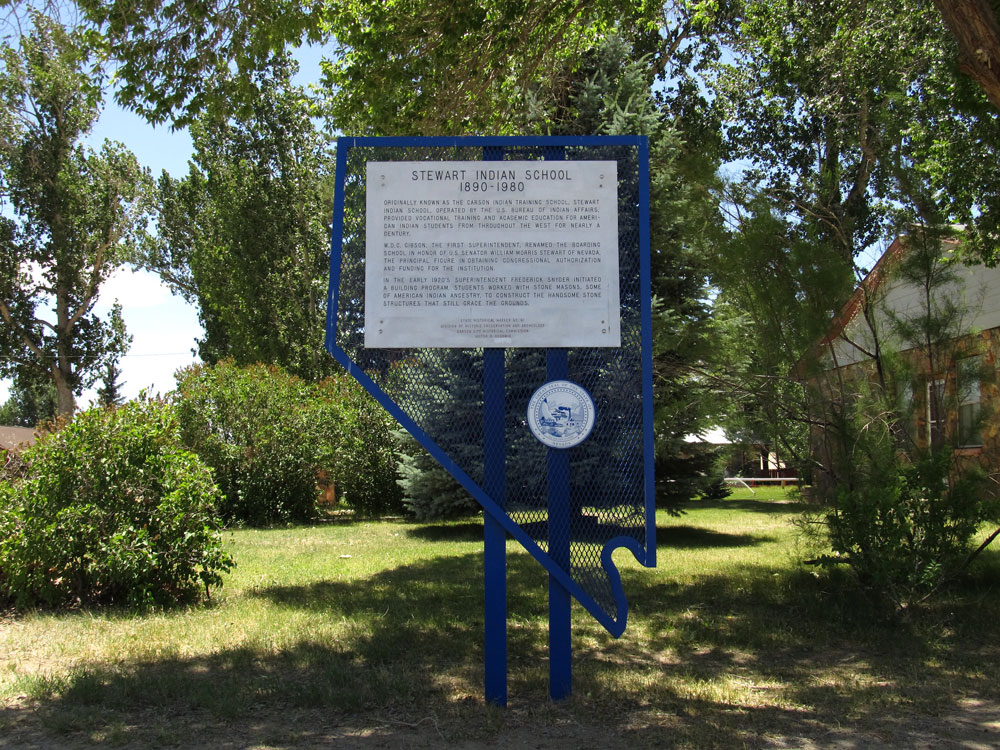
February 24, 2020; Las Vegas Sun
“Kill the Indian, save the man” was the infamous phrase reportedly uttered by Colonel Richard Henry Pratt in 1879 when establishing the Carlisle Indian Industrial School in Carlisle, Pennsylvania. The school in Carlisle had many imitators, as many as 100 by some estimates. Among these was a school established in 1890, near Carson City, Nevada.
“Native American children were kidnapped from their families and packed into wagons, trucks and trains to be taken off their reservation,” writes Kelcie Grega in the Las Vegas Sun. “At the Stewart Indian School, their hair was cut, they were forced to wear military-style uniforms and relinquish their cultural heritage, and they were punished for speaking their native language.”
Grega adds:
The 240-acre boarding school in Northern Nevada was large and unfamiliar; the dorms cold and sterile. As one Western Shoshone tribe member described it, “We lost communication with our families at home. Half of them didn’t expect us to come home anyway.”
The school was established in 1888 by an act of the state legislature and turned over to the federal government after it was built in 1890. The school in Carson City operated for 90 years, before being shut down in 1980. Founded with an initial class of 37 students, it grew to have 400 students. Now the school has become a museum, the Stewart Indian Cultural School and Museum, dedicated to recalling the school’s tragic past.
“We really worked hard to make it an educational exhibit,” museum director Bobbi Rahder tells Grega. “We want people to know that what happened at these boarding schools was a cruel federal policy that still affects families.”
In a story by Jazmin Orozco Rodriguez of the Nevada Independent, Rahder adds, “This was a government policy, and it is genocide. It meets the [United Nations’] definition of genocide and there is no other word for it.”
Sign up for our free newsletters
Subscribe to NPQ's newsletters to have our top stories delivered directly to your inbox.
By signing up, you agree to our privacy policy and terms of use, and to receive messages from NPQ and our partners.
The effort to transform the school into a cultural center and museum has been years in the making, according to Stacey Montooth, Walker River Paiute and executive director of the Nevada Indian Commission. In 2017 and 2019, the Nevada state legislature allocated a total of $4.5 million to restore the buildings and create the museum and welcome center.
Grega notes that the museum, which had a soft launch last December and plans a formal opening in May, will include “a storytelling exhibit featuring the four main Native language groups spoken by 27 federally recognized tribes, bands, and colonies in Nevada—Wa She Shu (Washoe); Numu (Northern Paiute); Nuwu or Nuwuvi (Southern Paiute); and Newe (Western Shoshones). The display includes a class photo and art by students from the time.”
An important part of the effort has been the collection of oral histories. “Museum organizers collected hundreds of oral history interviews to tell stories from the school’s 90-year history,” Grega explains. Montooth tells Grega that the negative ramifications of Indian boarding schools are still being felt, as descendants of past alumni carry on the trauma of their forebears.
Grega adds, “In the oral histories collected by museum organizers, former students described instances of losing all contact with their families, having their heads shaved after being bathed in kerosene, and even enduring beatings simply for speaking their native languages.” In one story retold by Washoe tribe member Herman Fillmore, an elder was at his mother’s deathbed. He asked her in tears of anger, “Why didn’t you teach me the language and culture? She simply replied, ‘Because if you didn’t know it, they couldn’t beat it out of you.’”
Montooth observes that such experiences have contributed to distrust of the US education system by American Indians. “Even today, the expectation and value they put on public education is not what it would be had it not been for the boarding school era. It’s completely disheartening.” Montooth hopes that the museum is a step on the road to healing. She adds, “I wish I had money for every time my grandmother told me, ‘They can cut your hair, they can take our land, they can take our language, but they can’t take our mind’.”
Before it closed in 1980, Stewart did move away from its genocidal ideology. By the 1960s, students at Stewart could speak their native languages openly, and the school even became popular among American Indians. “Parents would send their children to school in the hopes they would receive an education and thought they might be better off at the boarding school, rather than at public schools, which could be seen as more racist,” Rahder relates to Orozco Rodriguez. It was federal budget cuts and earthquake safety concerns that forced the school’s closure in 1980.
The main exhibit is now complete, but museum efforts to educational programs continue. Among its goals are linking with schools; bringing Native artists inside the museum; and finding Native cultural instructors to teach classes in beadwork, basket-making, and harvesting.
Montooth emphasizes to Orozco Rodriguez too the importance of making accessible accurate accounts about boarding school history and American Indian history in general. Only in this manner, she says, can citizens become “wholly well-informed, civic-minded participant[s] in our democracy.”—Steve Dubb













